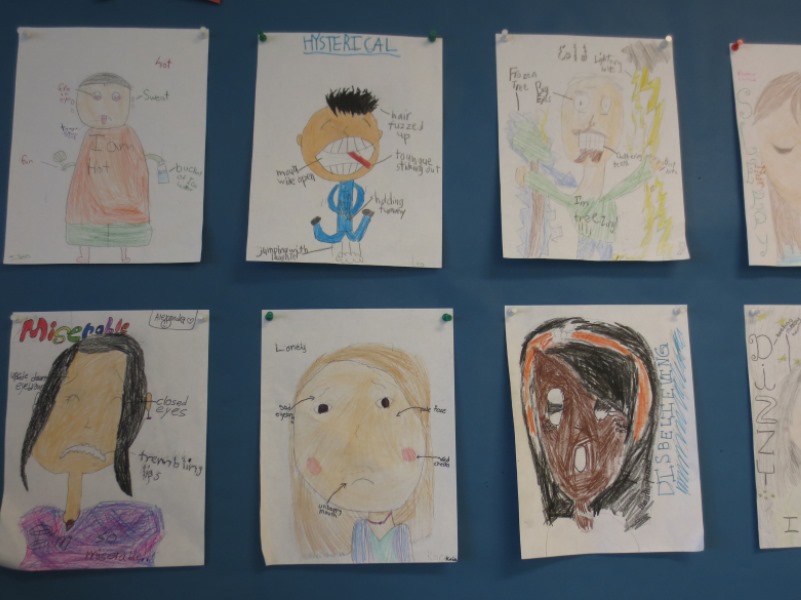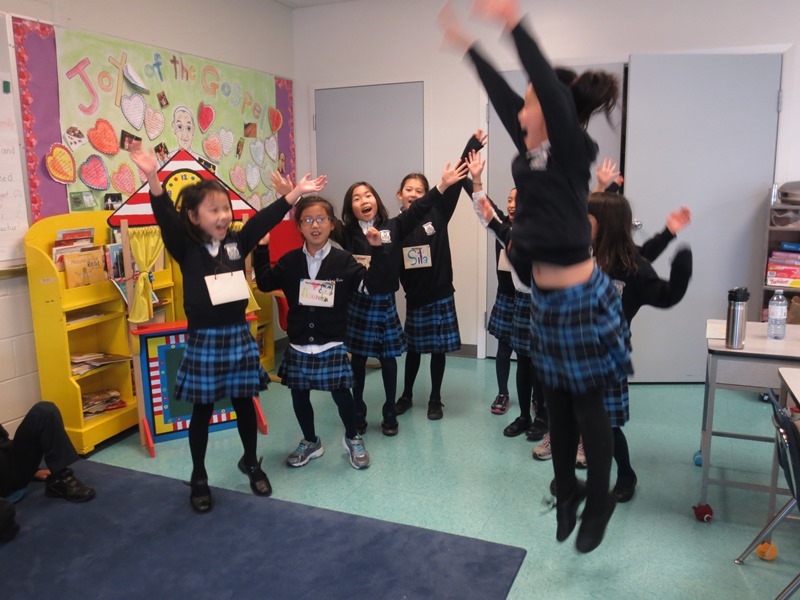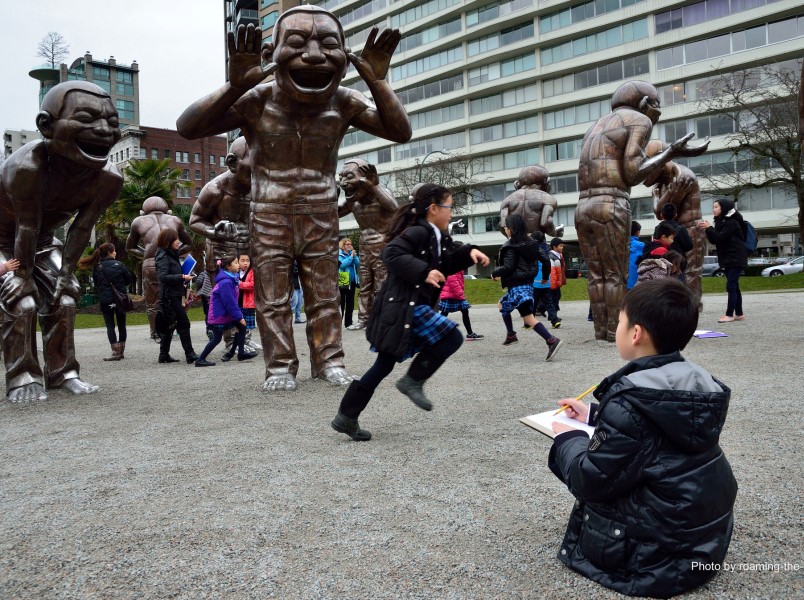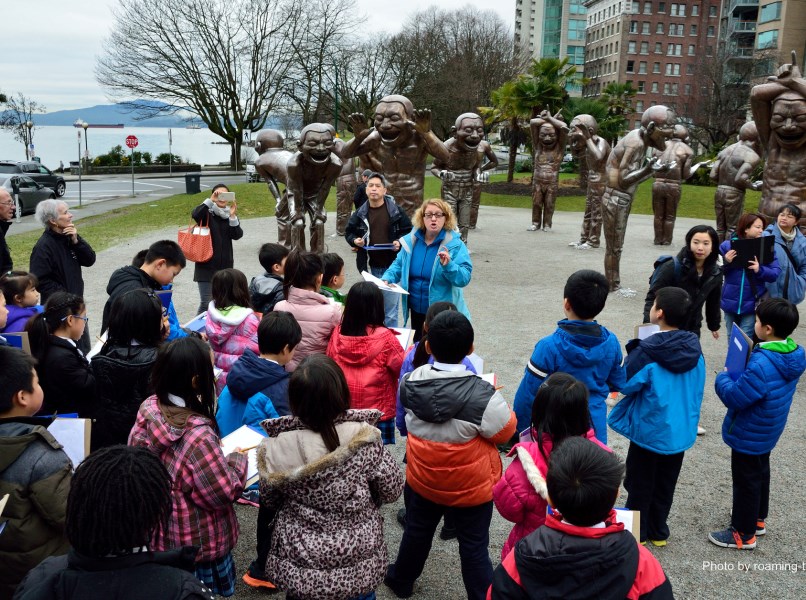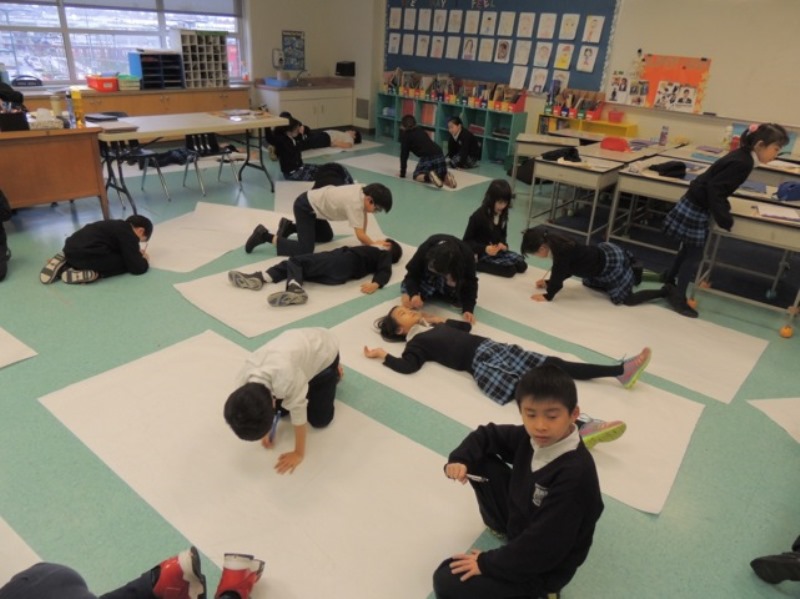St. Francis Xavier: The Impact of Human Emotions
Arts Education, Language Arts, Social Studies
School: St. Francis Xavier, Vancouver
Teacher: Soo Kim
Artist Collaborators: Lori Sherritt-Fleming
Class: Grade 3
Overview
The students explored how powerful emotions are in shaping our relationships with self and others. Students first explored the basic emotions such as: joy, sadness, anger, fear. Then through artwork (paintings, photography, sculpture), drama (movement, play), and writing (journal reflections, playwright) students dug into the endless possibilities of human emotions and its impact on our lives- physically, socially, and psychologically (self/others). Through this inquiry process, the students came to realize that emotions are universal, regardless of age, gender, race, ability/disability. Issues explored through this project-based learning include:
a) SELF (ME): self-esteem, confidence, fears, how to express emotions and why it is important to let emotions out
b) ME + YOU (WE) Social interaction with others (empathy, sympathy)
c) Social responsibility with the recognition of emotions which leads to topics such as anti-bullying and celebrating, accepting, understanding diversity
Connection to the Vancouver Biennale Exhibition
The class visited the A-maze-ing Laughter by Yue Minjun where the students examined different poses and postures of the laughing faces. The students observed, reflected, and wrote how they feel when they see the laughter, imagine what sounds they hear, and examine their own emotions as they do this.
BIG IDEAS
Learning to understand and recognize one’s emotions first is an important step to establish before one can accept and empathize with other people’s emotions. This skill is essential for students to develop and practice as this will play a crucial role in their social development and relationships, which directly relates to their physical and intellectual well-being in schools.
Guiding Questions
How do we express our emotions, communicate, and read non-verbal body language, facial expressions of self and others?
When can using non-verbal techniques be beneficial?
Cross-Curricular Access
• Arts Education: students communicated and perceived emotions through drama, spoken word, and visual art. Vocal, Theatrical/movement elements, creative process, imagination and play, presenting and performing
• Social Studies – Identity, Social Culture and Governance: Identifying and expressing emotion, developing empathy, relationships, rights and responsibilities, importance of communities, cultural similarities and differences, presentations
• Language Arts: Writing for a purpose and audience, reading, personal expression, generating and sharing ideas
Learning Process/Inquiry Challenges
• Recognizing MY (self) emotions: when I feel… how do I look… what’s my body posture like…how many emotions do/can we feel? What changes occur with different emotions?
• Understanding MY emotions: is it okay to feel…? How do I deal with ____ when I feel…? What are some ways to manage my emotions in productive ways?
• Communicating Emotions/Perceiving Emotions: expressing emotions through writing, drama, visual art, and spoken word
• Looking at examples of people’s expression through arts: photography, paintings, dance, sculpture and examining their “stories”
• Art Inquiry at the A-maze-ing Laughter: examining different poses and postures of the laughing faces through careful observation and respond through writing how they feel when they see and examine their own emotions as they do this.
• Emotions are universal: can be read, communicated by anyone regardless of gender, race, ability
Reference Resources:
Paintings: Mona Lisa (Leonardo da Vinci), Scream (Edvard Munch), Man with Guitar (Pablo Picasso), Baroque religious paintings of Christ
Dance/movement: ballet, drama, musicals, will inquire assistance from Vancouver Film School
Indigenous costume and masks for spiritual performances (West Coast Native or South American festivals) – will inquire assistance from Museum of Anthropology at UBC
Photography: depicting human expressions, will inquire assistance at Vancouver Film School
Poems/storybooks – level appropriate stories and poems
Unique architecture designs of cathedrals, homes- what emotions do buildings evoke?
Student Creation
Drama/spoken word: express different emotions using body language and facial expression without verbal communication
Visual Art: express a chosen emotion through visual art
A book of student poems inspired by A-Maze-ing Laughter with photos of their process and body murals included. A school book launch in April with the grade 3’s and their Kindergarten buddies.
Timeline
January
Planning and conceptualizing sessions. The artist and the teachers planned the entire project, enlisting the objectives, approach, workshop activities
Confidence builders workshop
Students wrote group poem on how do you know when someone is angry and other emotions
Field Trip at A-maze-ing Laughter – Students brought sketch books, encouraged to interact with the sculptures, notice the details of them, and question them.
Upon return to the classroom, students traced their body murals, based on the emotion in their poem and on some of the poses they saw in the sculptures.
Students worked in pairs to trace themselves.
Students collectively review What Am I?, the poem that was written collectively.
Each student, working with the emotion they chose to depict in their body panels, imagined what someone looks like when they express that emotion, and using the idea of looking at the emotion or sculpture from different angles, wrote their own poem.
February
Students continued working with their poems and practiced reading aloud.
Students worked on vocal graph and adding text to it.
Performance of the written poems.
March
Design and publishing of the book of written poems.
Reflection
Teacher – Soo Kim
My students and I truly enjoyed every minute of Lori’s enthusiastic and engaging workshops. As I planned and co-created this unit plan/project with Lori, I did not know how my students would react/respond it. A lot of my students are extremely shy and have never been exposed to drama. Therefore, I had mixed emotions myself of the possible outcomes. However, I wanted to challenge my students and expose them to another facet of the arts that I found great passion in.
To my pleasant surprise, my shy, sheltered students bloomed like spring flowers during Lori’s workshops. Reserved smiles slowly turned into giggles, then the giggles turned into joyful laughter that had everyone actively and emotionally engaged in the activities. Students felt comfortable around Lori and they let their silly, fun, brave, creative personalities pop out. As I participated and observed the lessons, I noticed how talented my students were. They just needed the opportunity and the guidance!
The beauty of our project was that it interweaved so well with cross-curricular subjects. My appreciation towards the arts was always a part of me, but it wasn’t as freely explored because of the nature of our school. Our school is highly academic, where the community seeks importance and value in subjects that are considered as ‘academic’ such as Math, Science and Reading/Writing. However, I wanted to challenge this presupposition through Vancouver Biennale. I wanted to demonstrate that art can enrich, foster, develop, and strengthen what our school community, specifically the parents of our students, believe as more important. The project Lori and I collaborated involved the body and the mind- which I feel needs to be balanced and equally valued.
The expressive exercises of performing arts boosted my students’ confidence and comfort level as they made this into a game. Moreover, their vocabulary naturally expanded as we discussed the imagery used in verbalizing our emotions. When we translated our body’s motions into words, students were able to make the connection between the body and the mind. Students had to carefully think about each body part and felt impelled to describe how each part has a role. It was a challenging task, but my students successfully surpassed my expectations.
Our visit to the Amazing Laughter exhibition was beyond a fun field trip. At first, the students were amazed at the size of the laughing sculptures, then they used their sense of humour to make comments about the body gestures, facial expressions and even on attire. Students at first were asked to explore and examine the sculptures. Then, they were given some time to sketch the sculptures. After that, we even had the students choose a camera angle (learned in the previous workshop with Lori), and capture the image with an iPad. Of course there was plenty of time for the students to run around and express their freedom around the exhibition. My guidelines and expectations were very brief and causal, and I wanted to keep it that way. The photos we took at the site captures the moments of freedom of expression, which tie in with the artist’s intent in making the sculptures.
Artist – Lori Sherritt-Fleming
This was an A-Maze-Ing journey. The entire project did what art was born to do: propel us all deeper, encourage us to engage our senses, expand our experience, find commonalities as humans as well as celebrate our differences. This process was not of the mind alone; it was also of the body and of the spirit as well as in collaboration and in community. It gave us all the opportunity to explore emotion and how we express it (or do not express it in some cases) and to develop sensitivities and awareness as to how different cultures and different ages choose to express or suppress ‘feeling’ and the effect it can have on those around them.
A moment of enlightenment for me came when we were on site visiting the A-Maze-Ing Laughter sculptures. As adults, we might look at them with our eyes, maybe touch a few with our hands and perhaps pose, mimicking the form and features of the sculptures. To the children, they represented something entirely different. They became a playground where there need be no inhibitions, where they could climb on the art, hang upside down from it, compare their bodies to the bodies in the sculptures and notice things, details that made them giggle. A couple of memorable moments, that followed us back to the classroom with immense giggling had to do with the position of some of the artwork. Some students stood between the ‘bums’ of two of the statues and plugged their noses, others pointed out the bare chests, and the ‘nipples’ that were exposed. They thought this was hilarious and giggled when I used the anatomical term. They enjoyed the ‘edginess’ of the piece and understood that art can take risks and that art depicts the world in different ways than how we see it on a day to day basis. They reminded me that art can be playful, that we can play with it and that it can make us laugh. It can also bring forth questions, deep questions about what it is to be human and this was what resonated with myself and the students the most in the long term.
The sculptures were a launching board into our own artwork, into our own perceptions, and modelled for us how we can be more sentient of the details around us, how we can slow down and process them to get answers and insight. Because the students had been encouraged to look at the art from different angles and to isolate what they saw through that lens, they experienced more. This increased their awareness and fed their vocabulary, both visual and written. It was much easier for them to find the words and phases for their poems and the details for their body murals once they had visited A-Maze-Ing Laughter.
As a writer, it was particularly enriching to work with the students on their poems. Many of the students in the class struggle with language and description and were using very base adjectives, nouns and verbs. I really enjoyed the rare opportunity to work with students one on one and ask them questions, questions connected to art and their vocabulary that helped them to discover that each of them could come up with and follow a strong theme and evolve it with powerful and evocative words. The difference between their drafts and their final poems was immense. The confidence in the room simply soared. I hope that the kinds of questions we asked as students created their own poems, are questions that sit with them and they apply for the rest of their lives. This entire project helped us to understand the importance of the art of questioning.
As a performer, this project also facilitated immense growth. Many of the students in Ms. Kim’s class were shy at first and hesitant to speak aloud. Part of the focus of this project was to help them find and use their expressive voices. I have to say this was a huge success as well. Students were able to use tone, pace, volume, emotion and colourful expression in their voices by the end of the project, tying visual art to textual art to vocal art and expression. They also came to question and understand how we express emotion and find their own answers to what is appropriate and what is not when feelings arise. They came to better understand the impact how we express ourselves has on others.
Finally, Ms. Kim was an incredible partnering teacher. She knows her students inside and out and nurtures and challenges them everyday. She did lessons in between my lessons that extended upon what we were exploring. She singlehandedly undertook the making of the body murals as well as the typing and collection of data. Her energy, creativity, questions, expertise and guidance were exemplary. She is also an awesome communicator and could help to redirect the lessons to best suit the needs of her class and curriculum.
All in all, I am grateful for the experience working with Vancouver Biennale and its partners and have been enlightened and inspired by the process.
Students
These are some of the comments made by the students in verbatim:
“I enjoyed writing poetry with Ms.Lori. It was so much fun!” – Jaiden Hong
“Ms.Lori is amazing at acting!” – Alexandra Lo
“Ms.Lori is such a great teacher- I really enjoyed the field trip to the Amazing Laughter.” – Aiden Lau
“Ms.Lori is awesome and makes more kids confident.”- Lori Lai
“Ms.Lori makes learning fun.” -Nathan Liou
“I liked this project because I learned to be brave on stage.” –Oscar Luu
“I loved the field trip to Amazing Laughter!! I loved taking pictures with my group! The statues were hilarious!” Aisha Lee-Izawa
“Ms.Lori did a wonderful job teaching us with voice lessons and activities. Next year’s grade 3 students should do this so they can learn about expressing their feelings and more!” Isabel Sengsavenh
“I enjoyed having a field trip to the Amazing Laughter sculptures. I enjoyed it because there was nature around me. I think Ms.Lori helps people be more confident in front of people.” Miriam Chan
“I really enjoyed when she asked us to go in a circle and we would all go inside the circle and do weird poses.” She is very creative and funny. I want other students to experience acting like we did and learn how to have a strong voice.” Phoebe Chen
“I enjoyed the voice lessons because I learned to express my voice with different tones. Ms.Lori’s teaching was fun, exciting and creative!” Kasia Kin-Leung
Credits
Photo at the A-Maze-ing Laughter taken by roaming-the-planet
